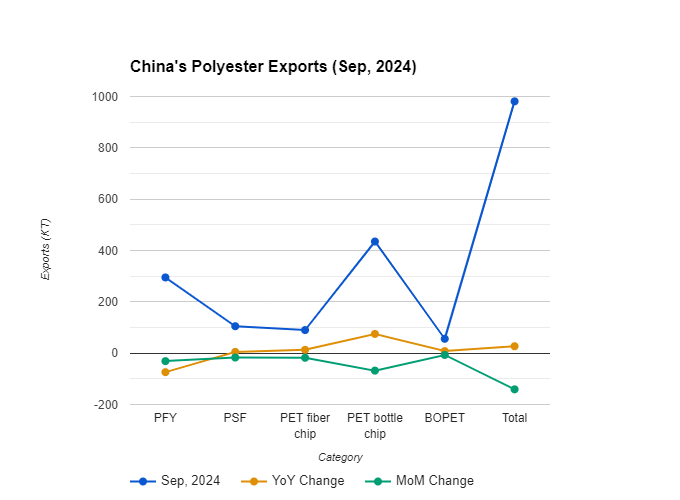Global Polyester Market: September exports decline across the board, signalling uncertain future

The global polyester market is facing headwinds as export figures for September reveal a decline across all product categories. This downturn, mirrored in key markets like China and India, raises concerns about the immediate future of the industry.
China's September slump
Recent customs data highlights, China's total polyester exports in September 2024 reached 981,000 tons. While this represents a 27,000-ton increase year-on-year, it marks a significant 141,000-ton drop compared to August 2024. This decline was observed across all polyester categories, including polyester filament, staple fiber, PET fiber chips, PET bottle chips, and BOPET films.
Table: China's Polyester Exports (Unit: KT)
|
Category |
Sep, 2024 |
y-o-y |
m-o-m |
|
PFY |
295 |
-74 |
-31 |
|
PSF |
105 |
5 |
-17 |
|
PET fiber chip |
90 |
13 |
-18 |
|
PET bottle chip |
435 |
75 |
-68 |
|
BOPET |
56 |
8 |
-7 |
|
Total |
981 |
27 |
-141 |
There were several reasons for a drop in exports. The slowdown in China's economy is a significant reason. Reduced consumer spending and manufacturing activity within China have dampened domestic demand, impacting both production and export volumes.
Additionally, the global economic slowdown is impacting demand from key export markets. Rising inflation and recessionary fears in major economies like the US and Europe have led to decreased consumer spending on non-essential goods, including textiles and apparel, which are major end-uses of polyester.
Furthermore, fluctuations in the RMB exchange rate have created uncertainty in the market, making international buyers hesitant to commit to large orders. This cautious sentiment was particularly evident during August and September when the RMB experienced significant volatility.
India's polyester industry faces challenges
India's polyester industry, a significant player in the global market, is also grappling with challenges. Recent data suggests a decline in polyester yarn exports, impacted by factors such as Turkiye's safeguard measures and the influx of cheaper Chinese imports. The Indian government's QCO mandating BIS certification for imported yarn has led to a decline in cheaper polyester yarn imports from China. Plus, the imposition of an MIP has further restricted imports of cheaper polyester fabric from China.
Table: India’s polyester yarn exports (in $ million)
|
Year |
Export Value |
|
2022-23 |
23.55 |
|
2023-24 |
22.18 |
Global outlook
The decline in polyester exports is attributed to various factors, including weakening global demand, fluctuating exchange rates, and geopolitical uncertainties. The industry is also facing pressure from increasing raw material prices and growing environmental concerns.
Indeed, the immediate future of the polyester industry appears uncertain. While some analysts predict a gradual recovery in the coming months, others remain cautious, citing persistent global economic challenges. The industry's ability to adapt to changing market dynamics, innovate, and address sustainability concerns will be crucial for its long-term growth.
